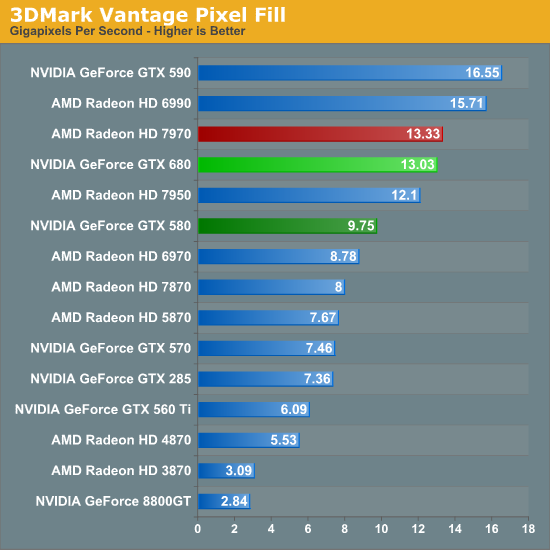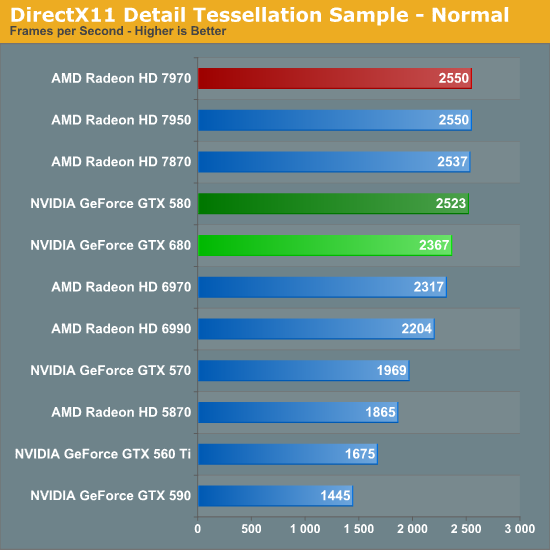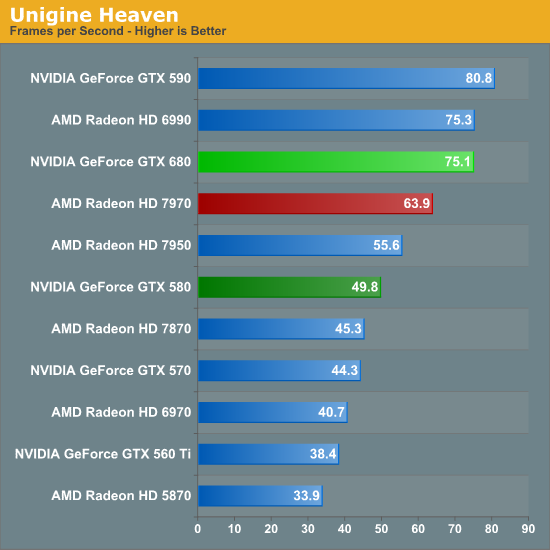NVIDIA GeForce GTX 680 Review: Retaking The Performance Crown
by Ryan Smith on March 22, 2012 9:00 AM ESTTheoreticals
As with any new architecture, we want to take a few moments to look at theoretical performance. These numbers shouldn’t be taken too seriously for cross-vendor comparison, but these numbers often tell us more about interesting architectural improvements that occur from one generation to the next.

Our first theoretical test is perhaps the most perplexing: 3DMark Vantage’s pixel fill test. Typically this test is memory bandwidth bound as the nature of the test has the ROPs pushing as many pixels as possible with as little overhead as possible, which in turn shifts the bottleneck to a mix of ROP performance and the memory bandwidth needed to feed those ROPs.
Compared to the GTX 580, the GTX 680 has almost exactly the same amount of memory bandwidth (192GB/sec) and only 86% of the theoretical ROP performance (37Gpix vs. 32Gpix). In short, it shouldn’t outperform the GTX 580 here, and yet it outperforms the 580 by 33%.
Why does it do this? That’s the hard thing to answer. As we mentioned in our look at GK104’s architecture, NVIDIA did make some minor incremental improvements to their ROPs coming from GF114, such as slightly improved compression and improved polygon merging. One of those may very well be the contributing factor, particularly the compression improvements since this is a typically memory bandwidth bottlenecked test. Alternatively, it’s interesting to note that the difference between the two video cards is almost identical to the difference in the core clock. GTX 560 Ti’s results tend to blow a hole in this theory, but it bears consideration.
In any case, it’s an interesting turn of events and hopefully one that isn’t simply an edge case. As we’ve seen in our benchmarks GTX 680 has strong performance – even if its lead compared to the 7970 diminishes with resolution – but compared to the GTX 580 in particular it needs strong ROP performance across all games in order to deliver good performance at high resolutions and anti-aliasing.

Our second theoretical test is 3DMark Vantage’s texture fill test, which to no surprise has the GTX 680 handily clobbering all prior NVIDIA cards. NVIDIA’s inclusion of 128 texture units on GK104 versus 64 on their previous generation GPUs gives the GTX 680 far better texturing performance. The 30%+ core clock difference only serves to further widen the gap.


Our third theoretical test is the set of settings we use with Microsoft’s Detail Tessellation sample program out of the DX11 SDK. Overall while NVIDIA didn’t make any significant changes to their tessellation hardware (peak triangle rate is still 4/cycle), they have been working on further improving performance at absurdly high tessellation factors. You can see some of this in action at the max factor setting, but even then we’re running into a general performance wall since the Detail Tessellation program can’t go to the absolute highest tessellation factors NVIDIA’s hardware supports.

Our final theoretical test is Unigine Heaven 2.5, a benchmark that straddles the line between a synthetic benchmark and a real-world benchmark as the engine is licensed but no notable DX11 games have been produced using it yet. In any case the Heaven benchmark is notable for its heavy use of tessellation, which means it’s largely a proxy test for tessellation performance. Here we can see the GTX 680 shoot well ahead of the GTX 580 – by more than we saw in the DX11 Detail Tessellation sample – but at the same time there’s a lot more going on in Heaven than just tessellation.
Honestly at this point in time I’m not sure just how much more tessellation performance is going to matter. Until DX11 is the baseline API for games, tessellation is still an add-on feature, which means it’s being used to add fine detail to specific models rather than being used on everything in a game world. This demands good tessellation at high factors but at the same time it’s subject to diminishing returns on the improvement to image quality as triangles reach single pixel sizes and smaller. To that end I’m still waiting to see the day where we see tessellation scale similarly to textures – that is by using full MIP chaining of displacement maps – at which point we can evaluate tessellation performance similar to texture performance when it comes to both measuring the performance hit and evaluating the difference in image quality.










404 Comments
View All Comments
Exodite - Thursday, March 22, 2012 - link
I'm a bit confused regarding the multi-display output options, which is a shame as the ability to drive more than two displays at once is something that'll once again make Nvidia interesting for me personally.I regularly run two separate DVI displays for my desktop/work and a HDMI-attached TV for mainly media and some couch surfing.
Will this setup work without issues with the GTX 680?
What kind of power level will it put the card in?
On my Radeon 6950 it bumps idle clocks significantly as soon as I enable multiple displays and I don't consider it an issue, I'm just curious about what the implications are for the GTX 680.
Thanks for an awesome review, as usual!
blanarahul - Tuesday, March 27, 2012 - link
Check techpowerup's review!SlitheryDee - Thursday, March 22, 2012 - link
This is great news. AMD's going to have fight nvidia in the pricing arena. There's going to be some great cards going for really cheap by this holiday season. Yay competition!CeriseCogburn - Thursday, March 22, 2012 - link
Woo hooooooooooo ! :-)kallogan - Thursday, March 22, 2012 - link
Good gpu but it's not a killer beast like it was announced...silverblue - Thursday, March 22, 2012 - link
I never expected it to be "as fast as three 580s in SLi" but it's still a very impressive piece of kit.I'm wondering how much performance is yet to come for both Keplar and Tahiti with driver updates, especially the latter.
ccjuju - Thursday, March 22, 2012 - link
I can't wait for this card to come out so I can buy a discounted 580 instead.TerdFerguson - Thursday, March 22, 2012 - link
"Battlefield 3 may be the most interesting game in our benchmark suite for a single reason: it’s the first AAA DX10+ game. It’s been 5 years since the launch of the first DX10 GPUs, and 3 whole process node shrinks later we’re finally to the point where games are using DX10’s functionality as a baseline rather than an addition."What, Just Cause 2 didn't count?
bhima - Thursday, March 22, 2012 - link
Bah, I wanted to see Anand review TXAA and NVIDIA's adaptive V-sync features.Ryan Smith - Thursday, March 22, 2012 - link
As you can probably tell, we're a bit behind schedule. We will be discussing both TXAA and adaptive v-sync, though for TXAA we won't technically be reviewing it since it's not available yet.